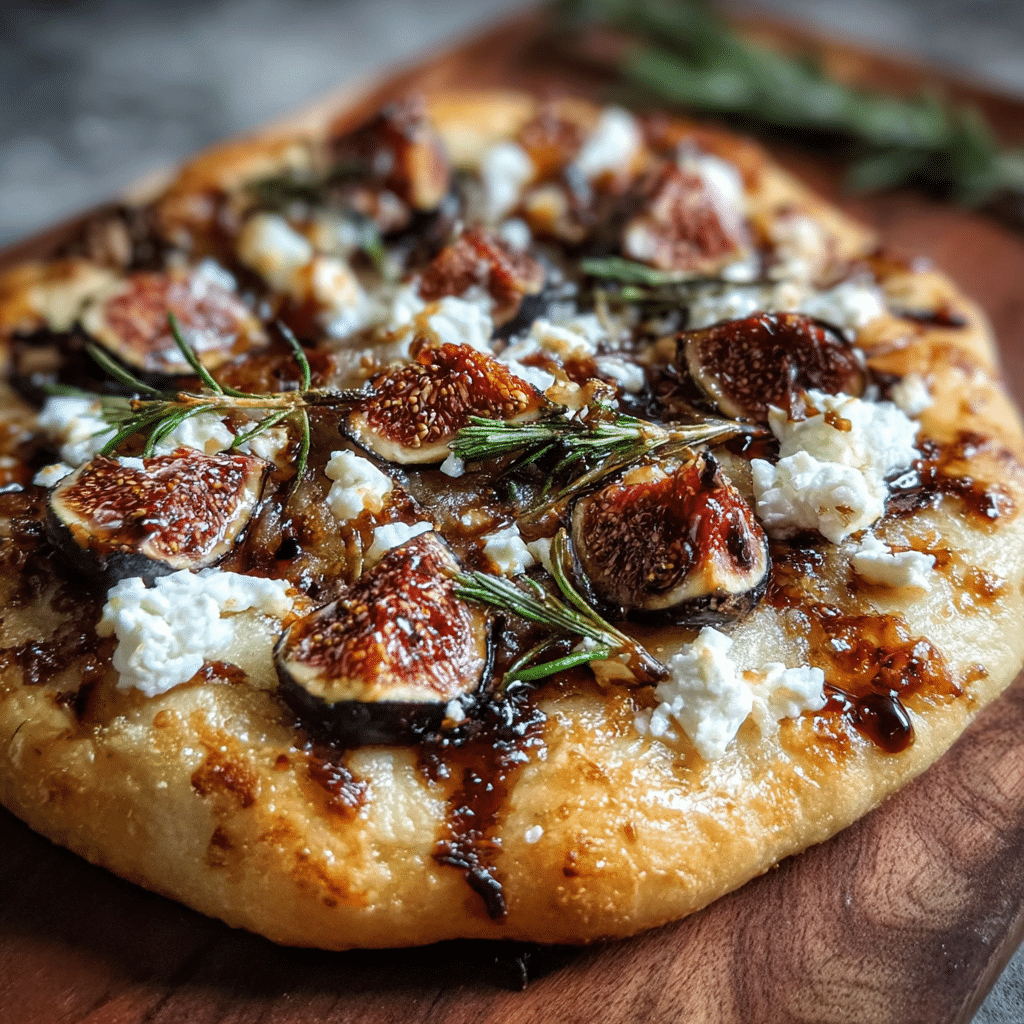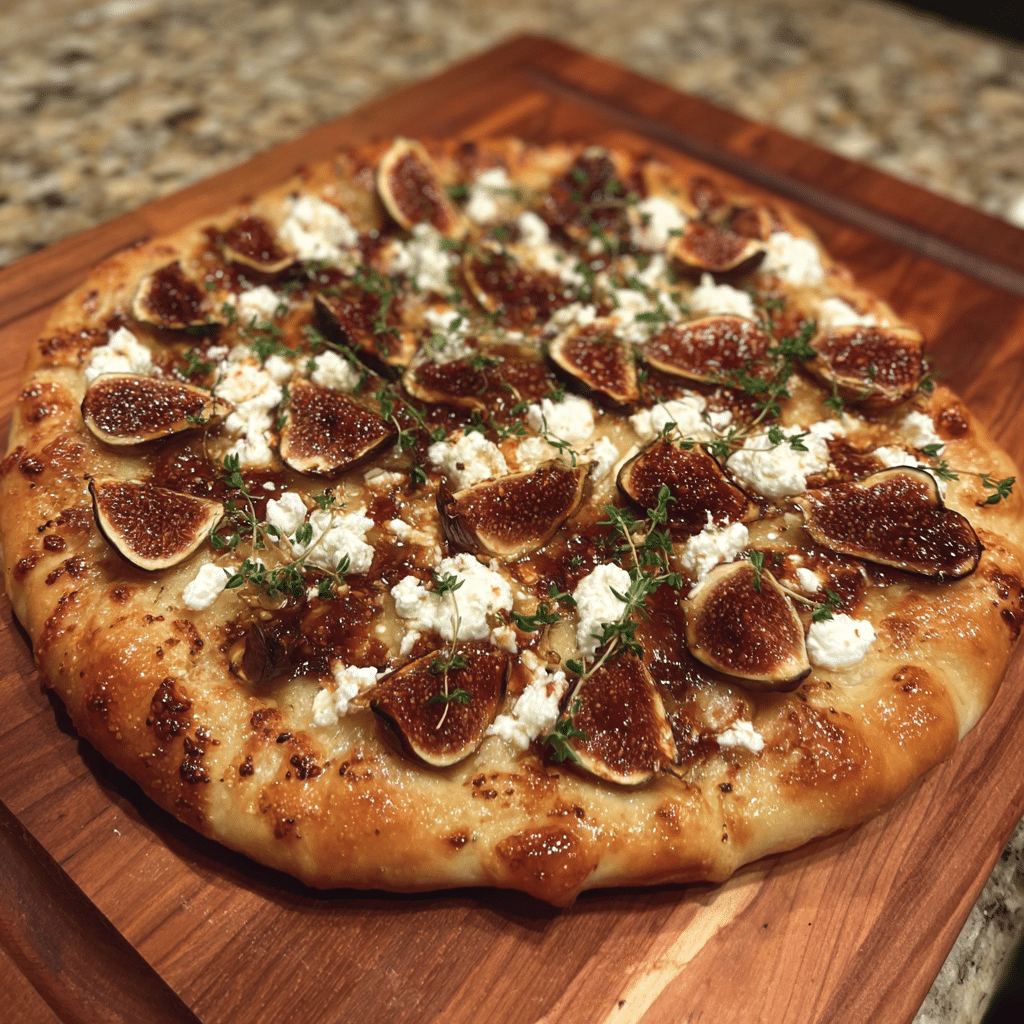Goat Cheese Pizza transformed my approach to entertaining after one memorable dinner party nearly ended in disaster.
I’m Jack from Cooks Foody, and five years ago I invited eight friends over for what I promised would be an “elevated Italian evening.” My plan was ambitious: handmade pasta, braised meats, multiple courses. By 7 PM, I was sweating over the stove with nothing ready to serve my arriving guests.
In desperation, I grabbed pizza dough from my freezer, smeared on fig jam I’d received as a gift, crumbled goat cheese on top, and hoped for the best. That improvised pizza became the star of the eveningveveryone asked for the recipe, and now this sophisticated yet simple combination is my signature dish.
Tired of boring, predictable pizzas that taste like every other delivery option? This fig jam and Goat Cheese Pizza delivers restaurant-quality sophistication with sweet-savory balance that elevates pizza from casual food to elegant dining.
As the recipe developer behind Cooks Foody, I’ve perfected the art of making impressive dishes that don’t require culinary school training. This pizza combines creamy, tangy goat cheese with sweet fig jam, peppery arugula, and a drizzle of balsamic glaze for a flavor profile that surprises and delights every time. You’ll discover why store-bought dough works beautifully (no need to make your own), my technique for preventing soggy pizza, the cheese distribution method that ensures every bite has perfect balance, proper baking temperatures for crispy crust, and serving strategies for both appetizers and main courses. Whether you’re planning a dinner party, date night, or simply want to upgrade pizza night, this recipe brings gourmet elegance to your table in just 25 minutes.
Why This Goat Cheese Pizza Recipe Works
This Goat Cheese Pizza recipe succeeds because it balances contrasting flavors and textures while remaining surprisingly simple to execute. After testing countless variations at Cooks Foody, I’ve identified the perfect combination of ingredients and techniques.
- Uses affordable, easy-to-find ingredients Store-bought pizza dough, fig jam, and goat cheese are available at most grocery stores without specialty shopping trips
- Ready in just 25 minutes from start to finish No lengthy dough rising or complicated techniques required; perfect for weeknight dinners or last minute entertaining
- Perfect for appetizers or main course meal Cut into small squares for elegant party bites, or serve large slices as a complete dinner with salad
- Sweet and savory flavor combination impresses guests The unexpected fig jam and goat cheese pairing feels sophisticated and restaurant-worthy despite simple preparation
- Vegetarian-friendly without sacrificing satisfaction This meatless pizza is so flavorful and filling that even dedicated meat-eaters won’t miss traditional toppings
Choosing the Right Ingredients for Goat Cheese Pizza
Selecting quality components creates the foundation for exceptional Goat Cheese Pizza. Each ingredient plays a specific role in the final flavor profile and texture.
Best Cheese Options for This Goat Cheese Pizza Recipe
Fresh goat cheese (chèvre) delivers superior results its tangy, creamy texture melts beautifully while maintaining distinct pockets of cheese throughout the pizza. Choose soft, spreadable goat cheese logs rather than aged, crumbly varieties. Full-fat goat cheese provides the richest flavor and creamiest texture; low-fat versions taste chalky and don’t melt as smoothly. For added complexity, mix goat cheese with a small amount of ricotta (80% goat cheese, 20% ricotta) to create even creamier texture. The tanginess of goat cheese balances the sweetness of fig jam perfectly.
Buying Tips for Goat Cheese Pizza Success
Purchase fresh goat cheese from the refrigerated specialty cheese section rather than pre-crumbled varieties, which contain anti-caking agents that prevent smooth melting. Check expiration dates and look for packages without excessive liquid watery cheese indicates age. For pizza dough, buy refrigerated dough from the bakery section or dairy case; frozen dough works but requires thawing overnight in the refrigerator. Select fig jam (not fig preserves, which contain large fruit chunks) with smooth, spreadable consistency. Fresh arugula should have vibrant green leaves without yellowing or wilting.
Ingredient Substitutions in Goat Cheese Pizza
Swap goat cheese for ricotta mixed with feta (1 cup ricotta plus ½ cup crumbled feta) for similar tangy flavor with milder goat taste. Replace fig jam with caramelized onions, honey drizzle, or apricot preserves for different sweet notes. Use baby spinach instead of arugula if you prefer milder greens. Substitute whole wheat pizza dough for added fiber and nutty flavor. For dairy-free versions, use cashew-based soft cheese though the flavor will differ significantly from traditional goat cheese’s distinctive tang.
Ingredients & Prep for Goat Cheese Pizza

Proper ingredient selection and minimal prep ensure your Goat Cheese Pizza comes together seamlessly. Organization matters when working with pizza dough and managing oven temperatures.
Dough and Base Essentials for Goat Cheese Pizza
Remove pizza dough from refrigeration 30 minutes before use to bring it to room temperature cold dough resists stretching and tears easily. If using frozen dough, thaw overnight in the refrigerator, then bring to room temperature. Lightly flour your work surface to prevent sticking, but don’t use excessive flour which creates tough crust. Let the dough rest if it springs back while stretching give it 5 minutes to relax the gluten. For crispiest results, prebake the crust for 3-4 minutes before adding toppings; this prevents soggy centers.
Toppings and Finishing Elements for Goat Cheese Pizza
For the Base:
- 1 pound pizza dough (store-bought or homemade)
- 2 tablespoons olive oil
- ¼ cup fig jam
- 1 clove garlic, minced (optional)
For the Toppings:
- 6 ounces fresh goat cheese, crumbled
- 2 cups fresh arugula
- ¼ cup thinly sliced red onion
- 2 tablespoons pine nuts or walnuts, toasted
- 2 tablespoons balsamic glaze
- Fresh thyme leaves (optional)
- Flaky sea salt
- Black pepper
For Prep:
- All-purpose flour for dusting
- Cornmeal for pizza peel (optional)
Pantry Staples for Goat Cheese Pizza
Keep these essentials stocked for spontaneous pizza-making: high-quality olive oil for brushing the crust creates golden, crispy edges. Fig jam stores for months in the refrigerator after opening it’s worth keeping on hand. Balsamic glaze (reduced balsamic vinegar) adds sweet-tart finishing notes; you can make your own by simmering balsamic vinegar until syrupy. Fresh arugula provides peppery bite that cuts through rich cheese; buy it the day you plan to use it for optimal freshness. Pine nuts or walnuts add textural crunch and nutty flavor; toast them briefly for enhanced taste.
Step-by-Step Cooking Instructions for Goat Cheese Pizza

Follow these precise steps for perfectly crispy, beautifully balanced Goat Cheese Pizza every single time. Temperature management and topping distribution are crucial for ideal results.
Pre-Baking Prep for Goat Cheese Pizza
Preheat your oven to 475°F (or as high as it goes, ideally 500°F) for at least 30 minutes before baking proper preheating ensures crispy crust. If using a pizza stone, place it in the oven during preheating; if using a baking sheet, preheat the sheet for crispier bottom crust. Let pizza dough come to room temperature for 30 minutes. On a lightly floured surface, gently stretch the dough into a 12-14 inch circle or rectangle, working from the center outward. Don’t use a rolling pin, which deflates air bubbles instead, use your hands to stretch gradually.
Assembling the Goat Cheese Pizza
Transfer stretched dough to a piece of parchment paper for easy handling. Brush the entire surface with olive oil, going all the way to the edges to prevent soggy crust. Spread fig jam in a thin, even layer over the dough, leaving a ½-inch border for crust. If using garlic, sprinkle minced garlic over the fig jam. Distribute crumbled goat cheese evenly across the pizza don’t clump it all in one area. Scatter thinly sliced red onion and toasted nuts over the cheese. The pizza should look relatively light on toppings compared to traditional pizzas; resist the urge to pile on ingredients.
Baking Method for Goat Cheese Pizza
Carefully transfer the parchment paper with pizza onto the preheated stone or baking sheet using a pizza peel or the back of another baking sheet. Bake for 10-14 minutes, rotating halfway through if your oven has hot spots. The crust should be golden brown and crispy on the edges, the bottom should be browned (lift with a spatula to check), and the cheese should be softened and slightly melted. If the top browns too quickly before the bottom crisps, lower the oven temperature to 450°F for the last few minutes.
Finishing and Serving the Goat Cheese Pizza
Remove pizza from the oven using the parchment paper as a sling. Immediately top with fresh arugula the residual heat will wilt it slightly while maintaining some crunch. Drizzle generously with balsamic glaze in a zigzag pattern across the entire pizza. Sprinkle with fresh thyme leaves if using, flaky sea salt, and freshly ground black pepper. Let the pizza rest for 2-3 minutes before slicing this allows the toppings to set slightly and prevents the arugula from sliding off. Cut into 8 slices for dinner or 16 small squares for appetizers. Serve immediately while the crust is still crispy.
If you enjoyed this recipe, be sure to share it with your friends or save it for later!
I’d love to see your unique twist feel free to share your photos on Pinterest
Pro Tips for Perfect Goat Cheese Pizza
These insider techniques elevate your Goat Cheese Pizza from good to extraordinary. I’ve learned these secrets through years of pizza experimentation at Cooks Foody.
Avoiding Soggy Goat Cheese Pizza
Never overload the pizza with toppings less is more for crispy crust. Use fig jam sparingly; a thin layer provides flavor without adding excessive moisture. Prebake the crust for 3-4 minutes before adding toppings if you’re prone to soggy centers. Brush the entire dough surface with olive oil before adding anything else; this creates a moisture barrier. Ensure your oven reaches full temperature before baking—insufficient heat steams the crust rather than crisping it. Add fresh arugula after baking, not before; raw greens release water during cooking and create soggy spots.
Essential Tools for Goat Cheese Pizza Success
Invest in a pizza stone ($30-50) if you make pizza regularly it absorbs moisture and creates restaurant-quality crispy crust. A pizza peel makes transferring pizza easier, though the back of a baking sheet works in a pinch. Keep parchment paper on hand for foolproof transfer without sticking. A pizza cutter or large chef’s knife cuts clean slices without dragging toppings. Use a pastry brush for even olive oil distribution. An oven thermometer ensures your oven actually reaches the temperature displayed—many ovens run 25-50 degrees off.
Storage and Reheating Goat Cheese Pizza
Store leftover pizza in an airtight container in the refrigerator for up to 3 days. The arugula will wilt completely, but the flavor remains excellent. Never reheat pizza in the microwave—it creates rubbery crust and soggy texture. Instead, reheat in a preheated 400°F oven for 8-10 minutes until the crust crisps again. Alternatively, reheat slices in a covered skillet over medium heat for 5-6 minutes; the steam softens the cheese while the bottom crisps. Freeze unbaked assembled pizza (without arugula) for up to 2 months; bake directly from frozen, adding 5 extra minutes to cooking time.
Flavor Variations for Goat Cheese Pizza
This versatile Goat Cheese Pizza adapts beautifully to different flavor profiles and seasonal ingredients while maintaining its essential sophisticated character.
Pear and Goat Cheese Pizza
Replace fig jam with thin slices of fresh pear (Bartlett or Anjou varieties work best) arranged in a single layer. Add crumbled blue cheese alongside the goat cheese for extra tang. Sprinkle with fresh thyme and rosemary before baking. After baking, drizzle with honey instead of balsamic glaze and top with candied walnuts. This autumn-inspired variation pairs beautifully with crisp apple cider and works wonderfully for holiday entertaining. The sweet pears complement the tangy cheese while providing juicy texture.
Mediterranean-Style Goat Cheese Pizza
Omit fig jam and spread the crust with a thin layer of pesto instead. Use goat cheese as the base, then add sun-dried tomatoes, Kalamata olives, artichoke hearts, and roasted red peppers. Finish with fresh basil leaves instead of arugula after baking. Drizzle with high-quality extra virgin olive oil rather than balsamic glaze. This savory variation eliminates the sweet element entirely, creating a more traditional pizza experience with Mediterranean flair. Perfect for those who prefer savory-only flavor profiles.
Caramelized Onion and Goat Cheese Pizza
Replace fig jam with deeply caramelized onions cooked low and slow until golden brown and sweet. The caramelization process takes 30-40 minutes but can be done days ahead. Add fresh thyme to the onions while cooking. Use goat cheese and gruyere together for nutty complexity. Top with crispy fried shallots after baking for added crunch. This variation offers sweet-savory balance without fruit-based sweetness, appealing to those who love French onion soup flavors.
Goat Cheese Pizza Variation Comparison Table
| Variation | Key Ingredients | Flavor Profile | Best For |
|---|---|---|---|
| Classic Fig & Goat Cheese | Fig jam, goat cheese, arugula, balsamic | Sweet-tangy, sophisticated | Dinner parties, date night, impressive entertaining |
| Pear & Blue Cheese | Fresh pear, goat cheese, blue cheese, honey | Sweet, creamy, autumn-spiced | Fall gatherings, holiday appetizers |
| Mediterranean | Pesto, sun-dried tomatoes, olives, artichokes | Savory, herbal, briny | Summer dinners, casual gatherings |
| Caramelized Onion | Caramelized onions, goat cheese, gruyere, thyme | Rich, deeply savory, French-inspired | Comfort food lovers, winter meals |
| Apple & Walnut | Apple slices, goat cheese, walnuts, maple drizzle | Sweet, crunchy, harvest-inspired | Brunch, autumn parties |
| Strawberry Balsamic | Fresh strawberries, goat cheese, basil, balsamic | Bright, fresh, spring-inspired | Spring gatherings, light dinners |
Serving Suggestions for Goat Cheese Pizza
Present your Goat Cheese Pizza with complementary sides and beverages that enhance the sweet-savory profile without overwhelming the delicate balance of flavors.
Serve the pizza immediately after adding arugula and balsamic glaze while the crust is still crispy and warm. For appetizers, cut into 16 small squares and arrange on a rustic wooden board or white platter. For main course, cut into 8 generous slices and serve 2 slices per person alongside a simple arugula salad with lemon vinaigrette. The peppery greens complement the pizza’s flavors beautifully. Add roasted Brussels sprouts or butternut squash for autumn dinners, or serve with tomato soup for a sophisticated twist on pizza and soup night.
For beverages, light to medium-bodied red wines like Pinot Noir or Beaujolais complement the sweet fig and tangy cheese without overpowering. White wine lovers should choose Sauvignon Blanc or unoaked Chardonnay for crisp contrast. Rosé works wonderfully during warm weather. For those who prefer beer, wheat beers or amber ales provide malty sweetness that harmonizes with fig jam. Non-drinkers will enjoy sparkling apple cider, herbal iced tea with honey, or sparkling water with fresh herbs. This pizza also works beautifully as part of an antipasto spread with olives, marinated vegetables, and cured meats for guests who want variety.
FAQs About Goat Cheese Pizza
Can I make Goat Cheese Pizza dough from scratch?
Absolutely, though store-bought dough saves significant time and works beautifully. For homemade dough, combine 3 cups flour, 1 tablespoon sugar, 2 teaspoons salt, 1 packet active dry yeast, and 1 cup warm water plus 2 tablespoons olive oil. Knead for 8-10 minutes until smooth, then let rise in an oiled bowl for 1-2 hours until doubled. Punch down and use immediately, or refrigerate up to 3 days for even better flavor development. Homemade dough provides slightly chewier texture and deeper flavor, but requires planning ahead.
How do I prevent the goat cheese from becoming too dry on my Goat Cheese Pizza?
Goat cheese can dry out under high heat if not protected. Prevent this by crumbling the cheese into smaller pieces rather than large chunks smaller pieces maintain moisture better. Add goat cheese during the last 5-6 minutes of baking rather than at the beginning; this prevents excessive drying while still achieving light melting. Alternatively, mix goat cheese with a tablespoon of cream or ricotta before adding to create extra moisture. Distribute cheese evenly rather than piling it high, which exposes more surface area to drying heat.
Is this Goat Cheese Pizza recipe suitable for vegetarians?
Yes, this recipe is completely vegetarian-friendly as written. All ingredients pizza dough, fig jam, goat cheese, arugula, nuts, and balsamic glaze contain no meat products. Ensure your store-bought pizza dough doesn’t contain lard (most commercial brands use vegetable oil). Check that your balsamic glaze doesn’t contain anchovies, though most brands are anchovy-free. This pizza provides satisfying protein from the goat cheese and healthy fats from olive oil and nuts, making it a complete vegetarian meal when paired with salad.
Can I prepare Goat Cheese Pizza ahead of time?
You can prep components ahead for easier execution. Stretch the dough and place it on parchment paper up to 2 hours before baking, covering loosely with plastic wrap at room temperature. Crumble goat cheese and slice onions up to 1 day ahead, refrigerating separately. Toast nuts and prepare balsamic glaze ahead. However, don’t assemble and top the pizza until ready to bake pre-topped dough becomes soggy. Partially bake the crust for 5 minutes, cool completely, then refrigerate. When ready to serve, add toppings and finish baking. This method works well for entertaining.
What’s the best way to reheat leftover Goat Cheese Pizza?
Never use the microwave it creates soggy crust and rubbery cheese. The best reheating method uses a skillet: place pizza slices in a dry, non-stick skillet over medium heat. Cover with a lid and heat for 5-6 minutes until the bottom crisps and cheese warms through. The lid traps steam that reheats toppings while the direct heat crisps the crust. Alternatively, reheat in a preheated 400°F oven for 8-10 minutes directly on the rack. For crispiest results, reheat on a preheated pizza stone. The arugula will be wilted, but flavor remains excellent.
Can I freeze Goat Cheese Pizza?
Yes, with caveats. Freeze unbaked pizza (assembled without arugula) wrapped tightly in plastic wrap then aluminum foil for up to 2 months. Bake directly from frozen at 475°F for 16-20 minutes. Alternatively, fully bake the pizza, cool completely, wrap well, and freeze up to 1 month. Reheat from frozen in a 400°F oven for 12-15 minutes. The texture won’t match freshly baked pizza the crust becomes slightly tougher and the cheese less creamy but it’s acceptable for meal prep. Add fresh arugula and balsamic glaze after reheating for best results.
Conclusion
Elevate your pizza night with this sophisticated Goat Cheese Pizza tonight your guests and family will be amazed by the restaurant-quality results! The combination of sweet fig jam, tangy goat cheese, and peppery arugula creates a gourmet experience that’s surprisingly simple to achieve at home.
Print
Goat Cheese Pizza 7 Secrets to Irresistible Gourmet Perfection
- Total Time: 25
- Yield: 4 servings (8 slices) 1x
- Diet: Vegetarian
Description
Gourmet Fig Jam & Goat Cheese Pizza ready in just 25 minutes! This restaurant-quality pizza combines sweet fig jam, tangy goat cheese, peppery arugula, and balsamic glaze on a crispy crust. Perfect for dinner parties, date nights, or elevated weeknight dinners. Vegetarian and incredibly impressive despite simple preparation.
Ingredients
1 pound pizza dough (store-bought or homemade)
2 tablespoons olive oil
¼ cup fig jam
1 clove garlic, minced (optional)
6 ounces fresh goat cheese, crumbled
2 cups fresh arugula
¼ cup thinly sliced red onion
2 tablespoons pine nuts or walnuts, toasted
2 tablespoons balsamic glaze
Fresh thyme leaves (optional)
Flaky sea salt
Black pepper
All-purpose flour for dusting
Instructions
1. Preheat oven to 475°F (or as high as 500°F) for at least 30 minutes. If using pizza stone, place in oven during preheating.
2. Remove pizza dough from refrigeration 30 minutes before use to bring to room temperature.
3. On a lightly floured surface, gently stretch dough into a 12-14 inch circle or rectangle using your hands (not a rolling pin), working from center outward.
4. Transfer stretched dough to parchment paper. Brush entire surface with olive oil, going to the edges.
5. Spread fig jam in thin, even layer over dough, leaving ½-inch border for crust. Sprinkle minced garlic over fig jam if using.
6. Distribute crumbled goat cheese evenly across pizza. Don’t clump cheese in one area.
7. Scatter thinly sliced red onion and toasted nuts over cheese.
8. Transfer parchment paper with pizza onto preheated stone or baking sheet using pizza peel or back of another sheet.
9. Bake for 10-14 minutes, rotating halfway through. Crust should be golden brown, bottom should be browned, and cheese softened.
10. Remove from oven using parchment paper. Immediately top with fresh arugula.
11. Drizzle generously with balsamic glaze in zigzag pattern. Sprinkle with thyme if using, flaky sea salt, and black pepper.
12. Let rest 2-3 minutes before slicing. Cut into 8 slices for dinner or 16 squares for appetizers. Serve immediately.
Notes
Don’t overload pizza with toppings—less is more for crispy crust. Use fig jam sparingly; thin layer prevents soggy center.
Add arugula after baking, not before. Raw greens release water during cooking and create soggy spots.
Brush dough with olive oil before adding toppings—this creates moisture barrier for crispier crust.
Ensure oven reaches full temperature before baking. Insufficient heat steams crust rather than crisping it.
For prebaked crust method: Bake plain dough 3-4 minutes, add toppings, then finish baking. Prevents soggy centers.
Reheat leftovers in covered skillet over medium heat for 5-6 minutes, or in 400°F oven for 8-10 minutes. Never microwave.
Store leftovers in airtight container for up to 3 days. Freeze unbaked pizza (without arugula) for up to 2 months.
Variations: Substitute pear slices for fig jam, use pesto instead of fig jam, or add caramelized onions for different flavors.
- Prep Time: 10
- Cook Time: 12
- Category: Main Course, Appetizer
- Method: Baking
- Cuisine: Italian, American
Nutrition
- Serving Size: 2 slices
- Calories: 385
- Sugar: 12g
- Sodium: 625mg
- Fat: 16g
- Saturated Fat: 6g
- Unsaturated Fat: 9g
- Trans Fat: 0g
- Carbohydrates: 48g
- Fiber: 3g
- Protein: 14g
- Cholesterol: 20mg
Keywords: goat cheese pizza, fig jam pizza, gourmet pizza, vegetarian pizza, easy pizza recipe

